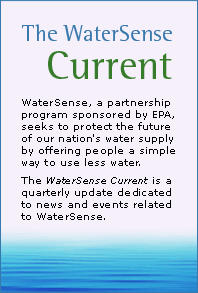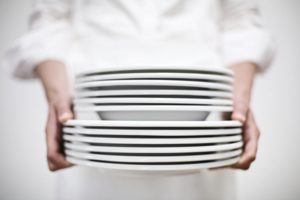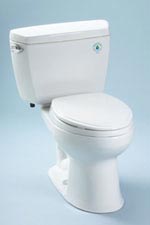The WaterSense Current Winter 2008
In This Issue V, Winter 2008:
 |
In This Issue: |
Make a Smaller Splash in 2008

It's
time to put a fresh spin on the classic New Year's resolution. Rather
than pledging to shed a few pounds this year, resolve to cut down
on daily water usage. WaterSense can help you keep this New Year's
resolution: use our simple tips to save water in the kitchen, bathroom,
laundry room, and yard, and save some green for yourself and for
the environment. Even New York City's Times
Square is catching on![]() !
We'll offer more tips throughout the year, so keep watching and
saving.
!
We'll offer more tips throughout the year, so keep watching and
saving.
 In the kitchen...
In the kitchen...
Resolution. If you wash your dishes in the sink, fill the basin with wash water, wash dishes in it, put dishes aside, and rinse them all together at the end.
Savings. If every home in the United States that washes dishes in the sink would do so in this manner, more than 100 billion gallons of water could be saved annually. In the bathroom...
In the bathroom...
Resolution. Install WaterSense labeled toilets throughout your home.
Savings. A household could save $90 per year in reduced water costs, and $2,000 over the lifetime of the toilets. In the laundry room...
In the laundry room...
Resolution. Make sure to wash only full loads.
Savings. Eliminate one load a week and save 2,130 gallons of water annually. In the yard...
In the yard...
Resolution. Hire a WaterSense irrigation partner to perform regular maintenance on your sprinkler system, and grow your lawn greener than ever.
Savings. If you have a sprinkler system, this could reduce the irrigation water you use by 15 percent or about 9,000 gallons annually—that's the amount of water that would flow from a garden hose nonstop for nearly a whole day.
Explore the WaterSense Web site to learn how you can save even more water in your home, and remember to check for updates and more information about WaterSense labeled products.
Toilet Selection Tops 100

In less than one year, more than 100 models of high-efficiency toilets have earned the WaterSense label, offering water-conscious consumers even more choices. These toilets have been independently tested to use less than 1.3 gallons per flush—about 20 percent more efficient than the federal standard—while offering equal or superior performance.
WaterSense labeled toilets are available at a wide variety of price points in a broad range of colors, styles, and models. A household that replaces its older toilets with WaterSense labeled models will, on average, save more than $90 per year in reduced water costs. Additionally, in many areas, utilities offer rebates and vouchers, which further lower the prices. View a complete listing of WaterSense labeled toilets.
Following close behind are faucets: Since the newest WaterSense specification was released in October 2007, more than 20 bathroom sink faucets and aerators have earned the WaterSense label. WaterSense labeled faucets and aerators will help reduce flow volumes by more than 30 percent without sacrificing performance. Look for them on store shelves in early 2008.
Partner Profile: Craig Borglum, Certified Irrigation Professional

WaterSense irrigation partners know how to spread the word. Craig Borglum, a certified irrigation designer and WaterSense partner in central Florida with more than 25 years of experience, is doing all he can to ensure that residents of his community, where water is in short supply, understand the importance of efficient irrigation.
Besides running a successful irrigation repair service, Borglum
maintains a Web log, or blog,
focused on water-efficient landscaping![]() where he discusses many aspects of sprinkler systems and lawn irrigation
for the general public. On his blog, he promotes WaterSense principles
and supplies information on topics ranging from drip irrigation
and how long lawns should be watered, to more general information
about water use, water efficiency, news and trends in water-efficient
lawn care, and what droughts will mean for citizens in the coming
years.
where he discusses many aspects of sprinkler systems and lawn irrigation
for the general public. On his blog, he promotes WaterSense principles
and supplies information on topics ranging from drip irrigation
and how long lawns should be watered, to more general information
about water use, water efficiency, news and trends in water-efficient
lawn care, and what droughts will mean for citizens in the coming
years.
Borglum also conducts free workshops for local homeowners that cover topics including sprinkler head repair and replacement of lawn sprinkler controllers. He offers free instruction on using water wisely and maintaining efficient irrigation systems, especially in times of drought. He also posts videos of his workshops online. These workshops are sponsored by the City of Ocoee, Florida, Utilities Department and the Protecting Ocoee's Water Resources Program and are hosted by local area libraries. Borglum filmed several workshops in July 2007 for Smart Irrigation Month and plans to conduct several more in February 2008 to prepare homeowners for spring watering. As an irrigation professional and WaterSense partner, Borglum successfully takes advantage of his position in the community to offer personal advice and specific information about water efficiency to others.
EPA is happy to welcome Craig Borglum to the WaterSense program and looks forward to working with him to promote water efficiency.
Drops to Watts: Have You Made the Water Use—Energy Connection?


Did you know that if you install water-efficient fixtures
and appliances, not only will you save water, but energy as
well? It's no accident that PATH, the public-private Partnership
for Advancing Housing Technology, recently named WaterSense
labeled toilets among its Top
10 Energy-Efficient Remodeling Projects![]() .
But how does saving drops save watts?
.
But how does saving drops save watts?
Although most people understand that heating water requires energy, they don't always consider the energy it takes to treat and deliver the water they use. In 2005, the nation's municipal water infrastructure consumed about 56 billion kilowatt hours of electricity—that's enough energy to power more than 5 million homes for an entire year. Plus, as the demand for water grows, water utilities must pump water from more distant and deeper sources, which, in turn, requires even more energy.
Conversely, while it takes vast amounts of energy to run our water infrastructure, it also takes vast amounts of water to cool power plants that generate our electricity. About half of the water gathered in the United States from surface and groundwater sources is used to cool power plants. On average, each kilowatt-hour generated requires approximately 0.2 to 0.3 gallons of water.
That's why a simple, high-efficiency flush can really make a difference when it comes to addressing global warming—the less water we use, the fewer greenhouse gases will be produced to generate electricity. Because WaterSense labeled toilets use about 60 percent less water per flush than the average toilet, installing them is a great place to start.
Even the simplest projects can yield big results. For example, screwing on WaterSense labeled faucet aerators, which usually cost only a few dollars a piece, can reduce a household's water use by more than 500 gallons annually and save enough energy to power a hair dryer for eight minutes a day for a whole year. It's a simple equation: using less water saves money, conserves energy, and ultimately protects both resources for the future.
Heard Around the Water Cooler
Take a cue from one of your fellow WaterSense Current readers and try this water-saving tip.
"When I'm waiting for my sink water to warm up for dishes,
I run the water into a pitcher and use it to water my houseplants.
If they're not thirsty, I just fill the pitcher and/or a water bottle
for later use."
— Kelli Zellner, from Elkridge, Maryland
Have a water-saving idea to contribute? E-mail it to us at watersense@epa.gov with "WaterSense Interactive" in the subject line.




